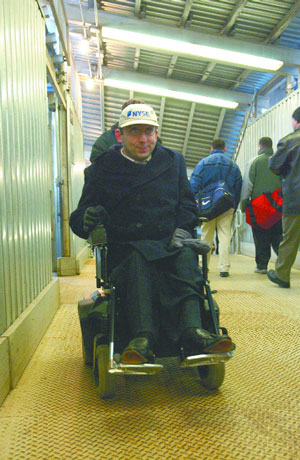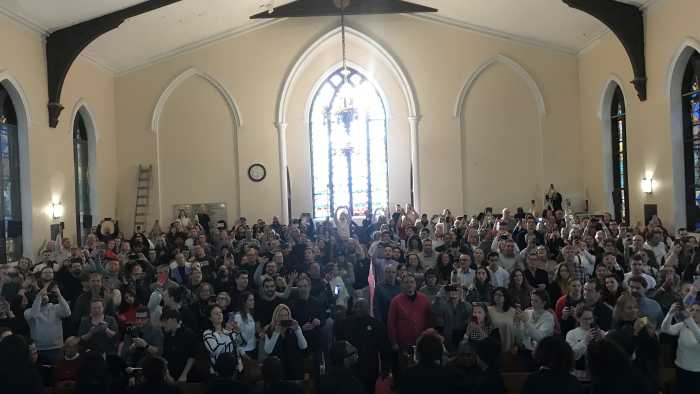By Josh Rogers
Volume 16 • Issue 39 | February 27 – March 4, 2004
A Long Way Home
Like many Battery Park City residents, Joseph Gibney works near Wall St. where the commute includes a short walk over or across the West Side Highway. Gibney guesses the trip would have taken him 10 minutes on his motorized wheelchair before Sept. 11, 2001 and thinks it could be just as quick now.
Gibney said he doesn’t mind that the trip typically takes him 20 minutes with the current state of handicapped-access into B.P.C. He’d just like to feel safe rather than having to choose between taking a rickety elevator to a pedestrian bridge over the thoroughfare or waiting for the light to cross a six-lane highway.
“It’s not a bad walk,” Gibney, an attorney, said of the trip before and after the highway. He spoke as he went from his office at Wall and Nassau Sts. to his Gateway Plaza apartment. “It’s not a dangerous walk if I didn’t have to go on the elevators.”
He has a home in Battery Park City and in New Jersey which he shares with his parents. He said he spends about four days a week in Battery Park City during the warmer months when the bridge elevators work more often and two or three days Downtown in the winter.
Gibney, 39, took the trip recently with a Downtown Express reporter and photographer. His father had told him the Liberty St. bridge elevator was working that afternoon. As he zipped down Wall and then over to Liberty St., Gibney seemed to slow down a little perhaps so that his media guests could keep up. But when he got to the Liberty bridge, the tables turned as we now were going to have to wait for him.
When he wheeled his way down the passageway to the elevator, Gibney said he was unable to push the button because a black gate was blocking the door. A businessman who was trailing us wheeling a heavy suitcase with technical equipment ended up pressing the button. Gibney warned the man that he probably would not be allowed to take the elevator. A few minutes later, a Brookfield Properties employee came down and told the businessman, who was on his way to a meeting in the World Financial Center, that the elevator was for the handicapped only. The man lugged his suitcase up the stairs and he still made it up faster than Gibney.
Two weeks ago a spokesperson for Brookfield, which operates and maintains the elevator leading to the firm’s W.F.C. offices, said that because the elevator breaks down so frequently, use is limited to people who are in wheelchairs, on crutches or are elderly. Brookfield executives are expected to attend a Community Board 1 meeting to discuss the Liberty bridge on March 2 at 6 p.m., 49-51 Chambers St., room 709.
When Gibney made it up to the bridge level, the elevator operator motioned to me to open the door to let Gibney and the operator out.
Asked what he would have done if no one was there to help, the operator said that Gibney had inadvertently made things harder by turning his wheelchair. “He turned to the right, if he started in the center it would have been alright,” the operator told me.
“That’s ridiculous,” Gibney said a few minutes later. “There’s not enough room for me and him.”
Melissa Coley, a Brookfield spokesperson, said two weeks ago that her firm has taken on the responsibility of maintaining the elevator and is looking for a long-term solution, but they inherited the problem from the city’s Dept. of Design and Construction, which built the elevator in the spring of 2002 as part of the ground zero cleanup.
Matt Monahan, D.D.C.’s spokesperson, said that the “urgent necessity was to reconnect people living in Battery Park City and going to the World Financial Center…. This hydraulic lift was a standard item and not custom made.”
Gibney, an attorney, said part of the problem is that there are so many different entities involved with the different bridge elevators that it’s hard to hold anyone accountable. “It’s not like I can grab one person and say ‘fix it,’ ” he said.
He filed an Americans With Disability Act complaint almost a year ago. He had said the assistant U.S. Attorney assigned to the case had not returned his repeated calls and letters. Subsequent to a recent Express article mentioning his assertion, Gibney said he received a one-sentence letter from the U.S. attorney’s office saying the case was still active.
“What’s he doing,” Gibney asked. “Is he calling anyone up?
Marvin Smilon, a spokesperson for the federal prosecutor’s office, said his office doesn’t comment on pending cases.
Gibney, who has limited strength in his arms, said the pedestrian bridge and elevators on Chambers St. are so far out of his way that he never takes those. He said he can’t take the pedestrian bridge on Rector St. by himself because he is unable to pull the elevator door open. That bridge was built by the state Dept. of Transportation and is maintained by the Battery Park City Authority.
“That’s totally wheelchair inaccessible,” Gibney said of Rector St. “These people just don’t get it.”
A B.P.C.A. official said the Rector elevator may not be perfect, but wheelchair-bound people with average arm strength can use it.
The third bridge, along Vesey St., opened in November without any handicapped access. There was a rush to open by November to accommodate the crowds expected from the reopened W.T.C. PATH commuter station. The second and final phase of the Vesey bridge was to be completed by April, under Gov. George Pataki’s Lower Manhattan timeline. Lisa Kuhner, a D.O.T. spokesperson, said the escalators will be done in April, but the elevators will be ready in June. They will have features intended to avoid the same pitfalls on Liberty and Rector.
Kuhner said the Vesey elevators will have a button — so people like Gibney should be able to get on and off by themselves. The hydraulic motors will have heating and cooling devices to avoid the liquid freezing up in the winter, said Kuhner.
Gibney remains skeptical he’ll have better luck on Vesey St.
After he wheeled across the bridge with us last week, he stopped at the heavy doors. I held it open for him and he went through. Gibney said since there are so many pedestrians walking through, he never has to wait long for someone to hold the door for him. We went to the W.F.C. office elevator which runs much more reliably than the bridge elevator. We took it down, got off, and then I held the door open for Gibney to get out and go the last leg to his building.
We got to his Gateway lobby and his doorman held the door for him. Before leaving, Gibney said he feels bad for mothers pushing strollers who get turned away at the elevator while he is allowed to go up — that is on days that it is working.
“I always thought it was women and children first,” he said. “That’s upsetting to me.”
Downtown Express photos by Elisabeth Robert
Reader Services
Read More: https://www.amny.com/business-finance/



































